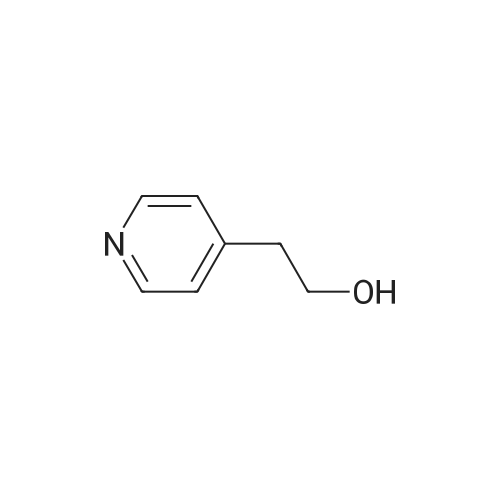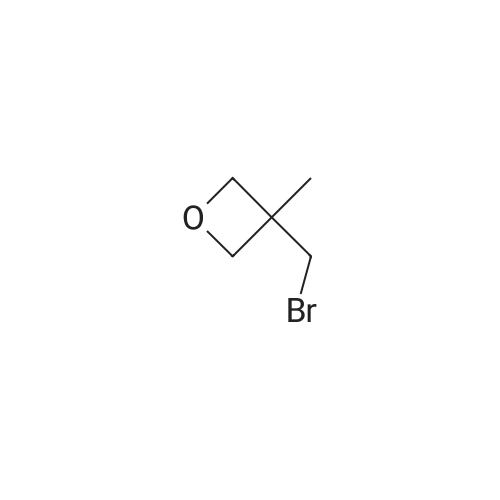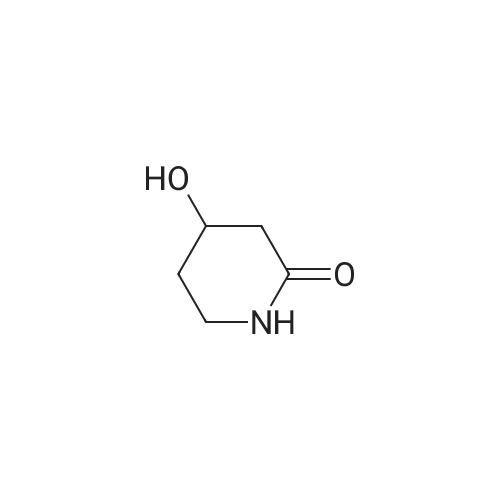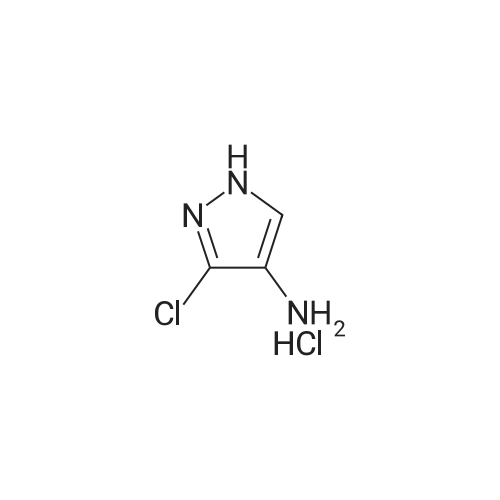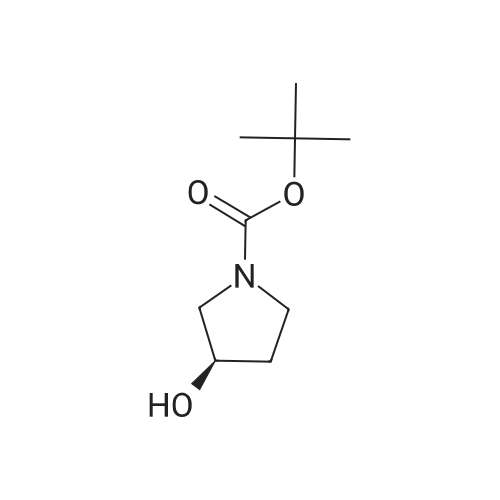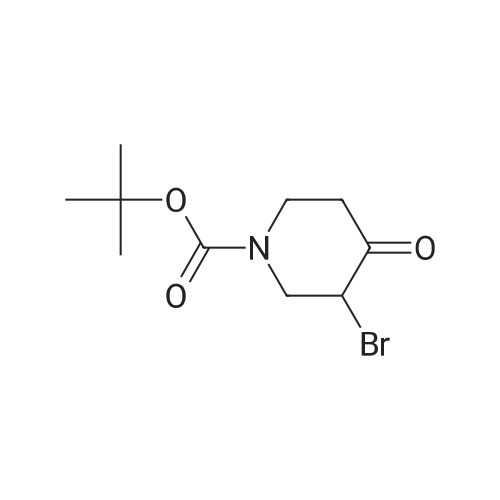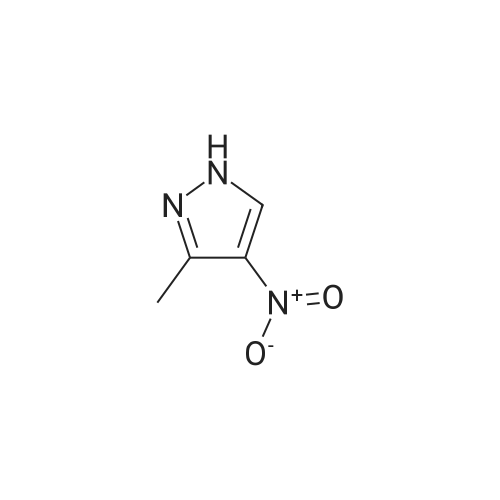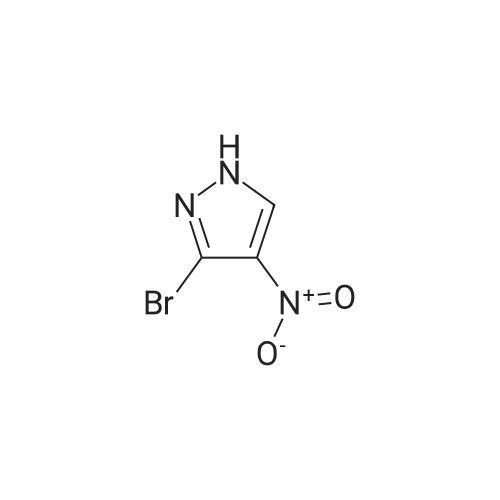| 95% |
With hydrogen;palladium 10% on activated carbon; In ethanol; at 20℃; under 2068.65 Torr; for 3h; |
Compound Ia (15.0 g, 133 mmol) was added to a suspension of palladium on carbon 10% (7.0 g, 6.65 mmol) in ethanol (100 mL). The mixture was shaken for 3 hours under hydrogen pressure (40 psi) at room temperature. The catalyst was removed by filtration through a pad of Celite and the solvent was evaporated. Compound Ib was obtained as a burgundy oil (10.5 g, 126 mmol, 95%) which was used in the following step without purification; GC/MS: m/z = 83 (100%). |
| 49% |
With hydrogen;1% Pd/C; In ethanol; under 1034.32 - 1551.49 Torr; |
A mixture of 4-nitro-l/f-pyrazole (1.13 g, 10 mmol), Pd/C (10%, 57 mg) in ethanol (20 mL) was hydrogenated at 20-30 psi on a parr apparatu overnight. The reaction mixture was filtered through celite, washed with ethanol (10 mL). The filtrate was concentrated to get desired compound 0113-42 (404 mg, 49%) as a brown solid. LC-MS: 84 [M+l]+; 1H-NMR (400 MHz, DMSO-d6) delta 3.11 (br s, 2H), 6.99 (s, 2H), 11.92 (s, IH). |
|
palladium; In ethanol; |
4-aminopyrazole (10) The 4-nitropyrazole (9) (15.0 g, 133 mmol) was added to a suspension of palladium on carbon 10% (7.0 g, 6.65 mmol, 5% mmol) in ethanol (100 ml). The mixture was shaken for 3 hours under hydrogen pressure (40 psi) at room temperature. The end of reaction checked by TLC (Ethylacetate/Hexane 1/1, 4-nitropyrazole Rf=0.6, UV active, 4-aminopyrazole Rf 0.1, UV active). The catalyst was removed by filtration through a pad of Celite and the solvent was evaporated. The product (10) was obtained as a burgundy oil (10.5 g, 126 mmol, 95%), which was used in the following step without purification. GC/MS: m/z=83 (100%). |
|
With hydrogen;platinum(IV) oxide; In ethanol; ethyl acetate; under 2280.15 Torr; for 2h; |
The 4-amino-l/i-pyrazole used as a starting material was prepared as follows :-A mixture of 4-nitro-l/J-pyrazole (0.7 g), platinum oxide (0.05 g), ethyl acetate (5 ml) <n="110"/>and ethanol (15 ml) was stirred under 3 atmospheres pressure of hydrogen for 2 hours. The catalyst was removed by filtration and the filtrate was evaporated. There was thus obtained the required starting material (0.5 g). |
|
With iron; ammonium chloride; In ethanol; water; at 80℃; for 2h; |
Step2:[00394] To a stirred mixture of iron (1.68g, 30 mmol), ammonium chloride (540mg, 10 mmol), water (2ml_) and ethanol (8ml_) at 800C was added 4-nitro-1 H-pyrazol (1 .13g, lOmmol) in portions. After completion of addition, the mixture was stirred at 800C for additional 2 hours. After cooling to room temperature, the mixture was diluted with ethyl acetate, and the resultant mixture was filtered through a pad of celite. The filtrate was concentrated to afford the crude title compound which was used at next step without further purification. MS (ES) [M+H]+ expected 84.0, found 84.0. |
|
With hydrogen;palladium 10% on activated carbon; In ethanol; under 760.051 Torr; for 22h; |
Intermediate (1e), 4-nitro-1 H-pyrazole (2.8g, 24.8mmol), was stirred in ethanol (20OmL) and the flask was evacuated and then flushed with nitrogen. Palladium, 10wt. % on activated carbon (300mg, catalytic amount) was added and after two vacuum / H2 cycles to replace the nitrogen inside with hydrogen, the mixture was shaken for 18 hours under ordinary hydrogen pressure (1atm). Palladium, 10wt. % on activated carbon (300mg) was added and after two vacuum / H2 cycles to replace the nitrogen inside with hydrogen, the mixture was shaken for a further 4 hours. The reaction mixture was filtered through celite and the filter cake was washed through with ethanol (2x50ml_). The combined washings and the filtrate were concentrated in vacuo. The residue obtained was triturated with ethyl acetate to yield a light pink solid, 1.48g, 72%. The filtrate subsequently obtained was concentrated in vacuo to yield another batch of sufficiently pure material, 0.54g, 26%, as a dark pink solid. |
|
|
4-Nitro-1 /-/-pyrazole (Manchester organics; 1.13 g, 9.99 mmol) was dissolved in ethanol (50 ml). This solution was added carefully to 10% palladium on carbon (Aldrich; 102 mg) under a nitrogen atmosphere. The atmosphere was exchanged to hydrogen, and the mixture was stirred vigorously at room temperature under a hydrogen atmosphere. After 45 min, ca. 700 ml of hydrogen had been taken up, and no further hydrogen was taken up over the next 30 min. Stirring was stopped and the atmosphere was exchanged to nitrogen. The solution was filtered through cellite (10 g cartridge) and washed with further ethanol (150 ml). Relevant fractions (as verified by TLC) were combined and concentrated in vacuo to give a red oil. Trituration with DCM gave the title compound (815 mg) as a red solid; 1 H NMR (MeOH-d4, 400 MHz) delta (ppm) 7.20 (2 H, s). |
|
With hydrogen;palladium 10% on activated carbon; In ethanol; at 20℃; for 1.25h;Inert atmosphere; |
Intermediate 5: 1 H-Pyrazol-4-amine. 4-Nitro-1H-pyrazole (Manchester organics; 1.13 g, 9.99 mmol) was dissolved in ethanol (50 ml). This solution was added carefully to 10% palladium on carbon (Aldrich; 102 mg) under a nitrogen atmosphere. The atmosphere was exchanged to hydrogen, and the mixture was stirred vigorously at room temperature under a hydrogen atmosphere. After 45 min, ca. 700 ml of hydrogen had been taken up, and no further hydrogen was taken up over the next 30 min. Stirring was stopped and the atmosphere was exchanged to nitrogen. The solution was filtered through cellite (10 g cartridge) and washed with further ethanol (150 ml). Relevant fractions (as verified by TLC) were combined and concentrated in vacuo to give a red oil. Trituration with DCM gave the title compound (815 mg) as a red solid; 1 H NMR (MeOH-d4, 400 MHz) delta (ppm) 7.20 (2 H, s). |
|
With hydrogen;palladium on activated charcoal; In ethanol; at 20℃; for 18h; |
A -(1H-Pyrazol-4-yl)-5-(m-tolyl)oxazole-4-carboxamide Step 1 : To a round bottom flask, 4-nitro-1 /-/-pyrazole (2.0 g, 17.68 mmol), Pd/C (200 mg, 1.89 mmol) and EtOH (15.0 mL, degassed) was added. The flask was evacuated and backfilled with H2 and the reaction mixture was stirred under H2-atmosphere at rt for 18 h. The reaction mixture was filtered over celite, washed with MeOH and the solvent was removed under reduced pressure to yield 1 H-pyrazol-4-amine as a red oil which was used without further purification. 1 H-NMR (400 MHz, DMSO) delta 3.72 (brs, 2H), 6.99 (s, 2H), 1 1.9 (brs, 1 H). |
|
With palladium 10% on activated carbon; hydrogen; In methanol; at 20℃; for 1h; |
Synthesis of compound 96.2[00605] A solution of 4-nitro-lH-pyrazole (200 mg, 1.77 mmol, 1.00 equiv) and 10% Palladium on carbon (40 mg) in methanol (5 mL) was degassed with H2 three times and the reaction mixture was stirred for 1 h at room temperature. The catalyst was filtered out and the filtrate was concentrated under vacuum to give 120 mg (crude) of compound 96.2 as a light yellow solid. |
| 3.6 g |
With palladium 10% on activated carbon; hydrogen; In ethanol; at 20℃; |
Dissolving 5.0 g of 4-nitropyrazole in 160 mL of ethanol, and then adding 0.8 g of 10 wt% Pd/C to the above solution; Hydrogen was introduced into the reaction solution and allowed to react overnight at room temperature; after the TLC detection reaction was completed, the insoluble matter was filtered off with diatomaceous earth; Evaporation of the ethanol solvent gave pure intermediate 2 as a red solid 3.6 g. |

 Chemistry
Chemistry
 Pharmaceutical Intermediates
Pharmaceutical Intermediates
 Inhibitors/Agonists
Inhibitors/Agonists
 Material Science
Material Science













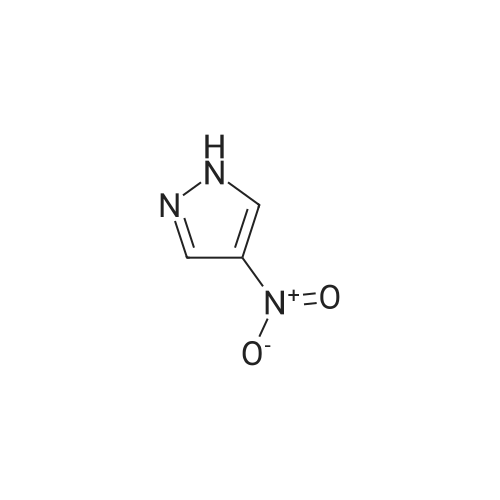

 For Research Only
For Research Only
 120K+ Compounds
120K+ Compounds
 Competitive Price
Competitive Price
 1-2 Day Shipping
1-2 Day Shipping













